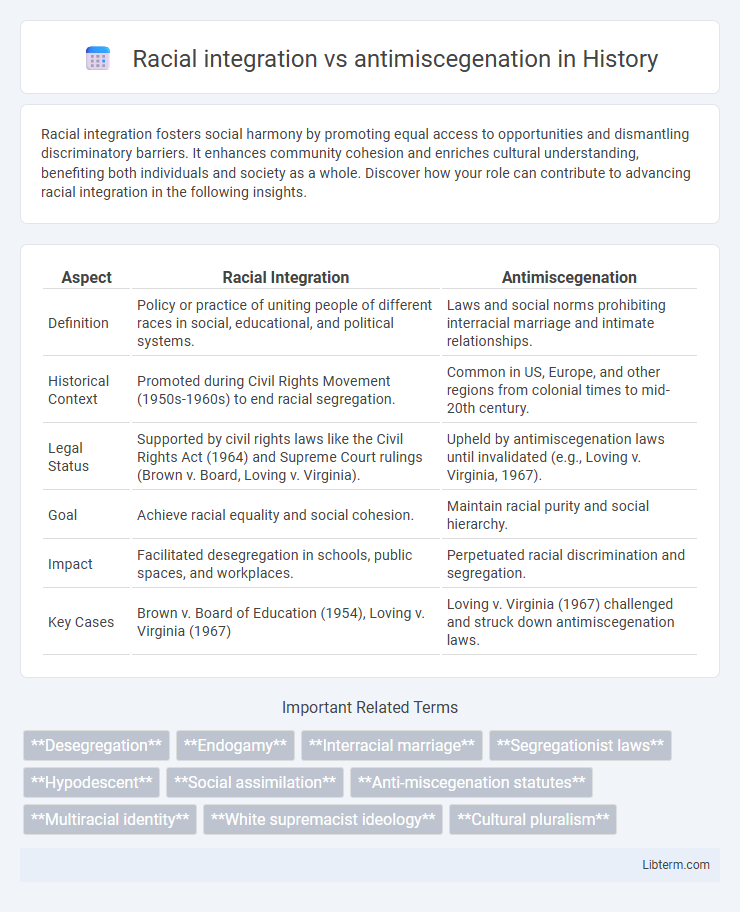Racial integration fosters social harmony by promoting equal access to opportunities and dismantling discriminatory barriers. It enhances community cohesion and enriches cultural understanding, benefiting both individuals and society as a whole. Discover how your role can contribute to advancing racial integration in the following insights.
Table of Comparison
| Aspect | Racial Integration | Antimiscegenation |
|---|---|---|
| Definition | Policy or practice of uniting people of different races in social, educational, and political systems. | Laws and social norms prohibiting interracial marriage and intimate relationships. |
| Historical Context | Promoted during Civil Rights Movement (1950s-1960s) to end racial segregation. | Common in US, Europe, and other regions from colonial times to mid-20th century. |
| Legal Status | Supported by civil rights laws like the Civil Rights Act (1964) and Supreme Court rulings (Brown v. Board, Loving v. Virginia). | Upheld by antimiscegenation laws until invalidated (e.g., Loving v. Virginia, 1967). |
| Goal | Achieve racial equality and social cohesion. | Maintain racial purity and social hierarchy. |
| Impact | Facilitated desegregation in schools, public spaces, and workplaces. | Perpetuated racial discrimination and segregation. |
| Key Cases | Brown v. Board of Education (1954), Loving v. Virginia (1967) | Loving v. Virginia (1967) challenged and struck down antimiscegenation laws. |
Historical Context of Racial Integration and Antimiscegenation
Racial integration in the United States took significant strides during the Civil Rights Movement of the 1950s and 1960s, challenging segregation laws and promoting equal access to education, public facilities, and employment for African Americans and other marginalized groups. Antimiscegenation laws, which prohibited interracial marriage and relationships, were enacted in many states from the 17th century through the mid-20th century to enforce racial boundaries and white supremacy. The landmark 1967 Supreme Court case Loving v. Virginia effectively invalidated all antimiscegenation laws, marking a crucial turning point in the legal and social recognition of interracial unions.
Defining Racial Integration: Concepts and Goals
Racial integration is the process of bringing different racial groups into equal participation within societal institutions, aiming to eliminate segregation and promote inclusivity in education, housing, and employment. It emphasizes the dismantling of systemic barriers to ensure equitable access to resources and opportunities for all races. The primary goal of racial integration is to foster social cohesion and racial equality by affirming diversity as a strength rather than a division.
Understanding Antimiscegenation: Origins and Laws
Antimiscegenation laws originated in the 17th century to prohibit interracial marriage and relationships, rooted in racial purity ideologies. These laws were enforced across many U.S. states until the landmark 1967 Supreme Court decision in Loving v. Virginia, which declared such statutes unconstitutional. Understanding antimiscegenation highlights the systemic barriers faced by racial integration efforts and the legal reinforcement of segregationist policies.
Societal Impacts of Integration Efforts
Racial integration promotes social cohesion by fostering diverse communities, reducing prejudice, and enhancing equal access to education and employment opportunities. Antimiscegenation laws historically enforced racial segregation, perpetuating discrimination and social inequity. The dismantling of these laws has led to increased interracial relationships and social mobility, contributing to a more inclusive society.
Legal Battles Shaping Antimiscegenation Policies
Legal battles over antimiscegenation laws were pivotal in shaping racial integration policies in the United States, with landmark cases such as Loving v. Virginia (1967) declaring state bans on interracial marriage unconstitutional. These rulings dismantled legal barriers that upheld racial segregation and promoted civil rights, influencing subsequent anti-discrimination legislation. The Supreme Court's decisions underscored the constitutional principle of equality, significantly advancing the cause of racial integration nationwide.
Cultural Narratives Influencing Both Movements
Cultural narratives drastically shaped both racial integration and antimiscegenation movements, as stories of shared humanity and equality propelled integration efforts while entrenched myths of racial purity upheld antimiscegenation laws. Media representations, religious rhetoric, and educational curricula played pivotal roles in framing interracial relationships either as a threat to social order or as a pathway to societal progress. These competing narratives influenced public opinion, legislative actions such as the landmark Loving v. Virginia case, and ongoing debates about race, identity, and marriage in America.
Key Figures and Activists on Both Sides
Prominent figures advocating racial integration include Martin Luther King Jr., who championed nonviolent resistance and equality, and Rosa Parks, whose refusal to give up her bus seat became a catalyst for the civil rights movement. On the opposing side, leaders like George Lincoln Rockwell, founder of the American Nazi Party, and individuals supporting antimiscegenation laws argued for racial segregation to maintain "racial purity." These key activists shaped public discourse and policy, influencing the legal battles surrounding interracial marriage and civil rights in 20th-century America.
The Role of Education in Shaping Attitudes
Education plays a crucial role in shaping attitudes toward racial integration and antimiscegenation by promoting awareness of historical injustices and fostering empathy through inclusive curricula. Schools that incorporate comprehensive teachings about civil rights movements and the scientific refutation of racial myths help reduce prejudice and encourage acceptance of interracial relationships. Effective educational programs contribute to dismantling segregationist ideologies and support the development of more equitable social norms.
Ongoing Challenges and Present-Day Legacies
Racial integration continues to face systemic barriers rooted in historical antimiscegenation laws that prohibited interracial marriage and relationships, reinforcing social divisions and racial hierarchies. Present-day legacies of these laws manifest in persistent racial prejudice, socioeconomic disparities, and underrepresentation of mixed-race families in social and legal frameworks. Efforts to promote equitable integration confront challenges like implicit bias, institutional racism, and the enduring stigma surrounding interracial unions.
Moving Forward: Pathways Toward Inclusive Societies
Racial integration promotes equitable access to social, economic, and political opportunities across diverse communities, fostering unity and reducing systemic discrimination. Antimiscegenation laws, historically designed to prevent interracial relationships, represent legal barriers that perpetuate segregation and racial hierarchies. Moving forward, dismantling residual segregation policies and advancing inclusive education, equitable housing, and anti-discrimination legislation are critical pathways toward achieving truly inclusive societies.
Racial integration Infographic

 libterm.com
libterm.com